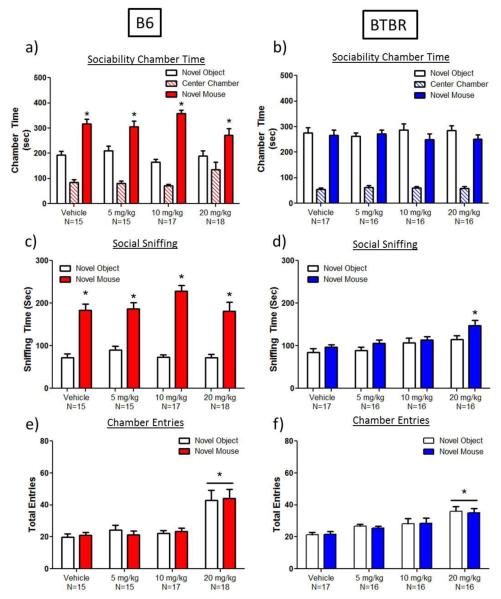Fig. 1.
Lack of specific effects of ganaxolone on 3-chambered social approach in adult C57BL/6J (B6) and BTBR T+Itpr3tf/J (BTBR) mice. a) B6 mice displayed normal sociability after vehicle or ganaxolone administration, as measured by more time spent in the chamber with the novel mouse than in the chamber with the novel object. b) BTBR mice displayed their characteristic lack of sociability, spending approximately equal amounts of time in the chamber with the novel mouse and in the chamber with the novel object after vehicle or ganaxolone. c) B6 mice administered vehicle or ganaxolone displayed significant sociability, spending more time sniffing the novel mouse than the novel object. d) BTBR mice administered vehicle or ganaxolone doses of 5 and 10 mg/kg exhibited a characteristic lack of sociability on the sniffing parameter, displaying approximately equal amounts of sniffing directed at the novel mouse and the novel object. In contrast, after treatment with the high dose of ganaxolone (20 mg/kg), BTBR displayed significantly more sniffing of the novel mouse versus the novel object as measured by observer-scored directed sniffing. e) B6 mice administered 20 mg/kg ganaxolone exhibited significantly higher entries into both side chambers during sociability testing. f) Similarly, BTBR mice administered 20 mg/kg ganaxolone displayed significantly higher entries into both side chambers during sociability testing. Higher entries, indicating more overall exploration, may confound the interpretation of specific social improvements at the 20 mg/kg dose of ganaxolone. a-d) *p<0.05, within drug treatment group (novel mouse compared to novel object). e-f) The black line indicates a main effect of drug, with no drug × chamber interaction. * p<0.0003, as compared to vehicle

